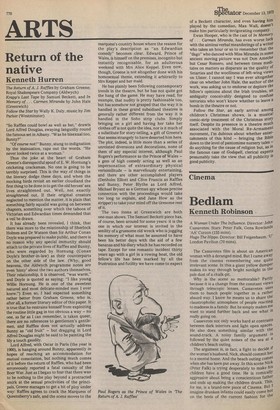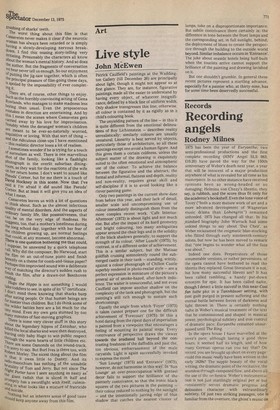Bedlam
Kenneth Robinson
A Woman Under The Influence. Director: John Cassavetes. Stars: Peter Falk, Gena Rowlands 'AA' Curzon (155 mins).
Hugo The Hippo. Director: Bill Feigenbaum. 1-1' London Pavilion (70 mins).
The Cassavetes film is about an American woman with a deranged mind. But I came away from the cinema remembering one quite irrelevant scene. In this a giant yellow dumper makes its way through bright sunlight in the pale dust of a chalk-pit.
Why is the scene so memorable? PartlY because it is a change from the constant views through telescopic lenses. Cassavetes uses them to bunch people together in a rather absurd way. I know he means us to share the claustrophobic atmosphere of people reacting to madness in a family. But he simply makes Me want to stand further back and see what is really going on.
Cassevetes not only works hard at contrasts between dark interiors and light open spaces. He also does something similar with the sound-track. A noisy family argument is followed by the quiet noises of the sea at a children's beach outing. The argument is, in fact, a fight to decide if the woman's husband, Nick, should commit her to a mental home. And the beach outing comes when she has been put away. In this scene Nick (Peter Falk) is trying desperately to make his children have a good time. He is comicallY aggressive about being a conscientious father and ends up making the children drunk. This, for me, is a brand-new piece of Cinema. But I imagine drunken infants could easily come hot on the heels of the current fashion for the gnashing of sharks' teeth.
The worst thing about this film is that Cassavetes never makes it clear if the neurotic Woman has always been retarded or is simply having a slowly-developing nervous breakaown. I find this teasing story-telling very irritating. Presumably the characters all know about the woman's mental history. And so does the author. But the fragments of conversation we hear never tell us enough. So our enjoyment of putting the jig-saw together, which is often
the principal pleasure of film-going these days, is spoiled by the impossibility of ever completing it.
There are, of course, other things to enjoy. Such as the horribly-convincing acting of Gena Rowlands, who manages to make madness less boring than usual. Even the preposterous mistakes in direction are entertaining. And by
this I mean the scenes where Cassavetes gets carried away by his love for improvisation. Notably when the deranged woman's children
are meant to be ever-so-naturally worried, inquisitive or loving. With that sort of thing —
and the ridiculous close-ups I have mentioned — this realistic director loses a lot of realism. I sometimes wonder if he is trying for a touch • of surrealism as well. There is one marvellous
shot of the family, looking like a flashlight Photograph in the overlit suburban diningroom, as they wait for the reactions of the wife on her return home. I don't want to sound like „Pseuds' Corner, but for me there is a touch of L'avid Hackney in this scene. Now that I've
said it I'm afraid it did sound like Pseuds' Corner. But at least it will give you an idea of What I mean.
Cassavetes leaves us with a lot of questions to think about. Such as the almost infectious titiality of mental disorders. And the aspects of ordinary family life, like possessiveness, that can be on the very edge of madness. He suggests, too, that a mother's loneliness during the long school day, together with her fear of the children growing up, are normal feelings
that could, at any moment, become abnormal. There is one question bothering me that could,
I suppose, be answered by a quick telephone call. Why did the composer, Bo Harwood, start t, he film on an out-of-tune piano and finish oreez
ily on a theme for comb-and-tissue paper?
Perhaps this improvised sound was a deliberate \',.vay of matching the director's sudden rush to 'fish the film, after a drawn-out Beethoven ending.
Hugo the Hippo is not something I would take toddlers to see, in spite of its 'LI' certificate. I doret mind them knowing that sharks burp after eating people. Or that human beings are tar nastier than children. But I do think some of the wilder battles here are a bit much for the tLily mind. Even my own gets stunned by too many minutes of fast-moving graphics. There is some very clever stuff in this story about the legendary hippos of Zanzibar, who !t•illed the local sharks and were then destroyed, aving only baby Hugo to win public respect Trough the warm hearts of little children etc.
are some Osmonds on the sound-track. ,,t1I sorry to say. But Burl Ives is there too, with .l\obert Morley. The nicest thing about the film
is that it owes little to Disney. And its
4,ado-naasochism has nothing of the unsubtle Nor.uta ---tY of Tom and Jerry. But not since The. t, Ight Porter have I seen anything as nasty as tle giant radish that is sliced in half and 413tr.°111PtlY has a swordfight with itself, culmin • „ ing in what looks like a mixture of fratricide 't),..c1 suicide.
Nothing but an inherent sense of good taste ''°°uld keep anyone away from this film.


































 Previous page
Previous page